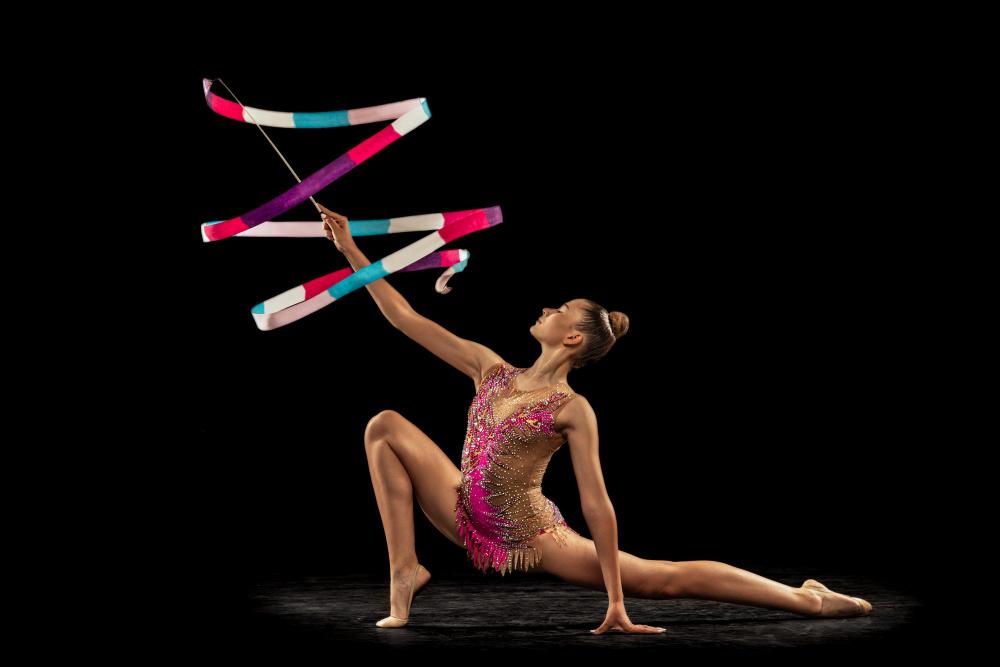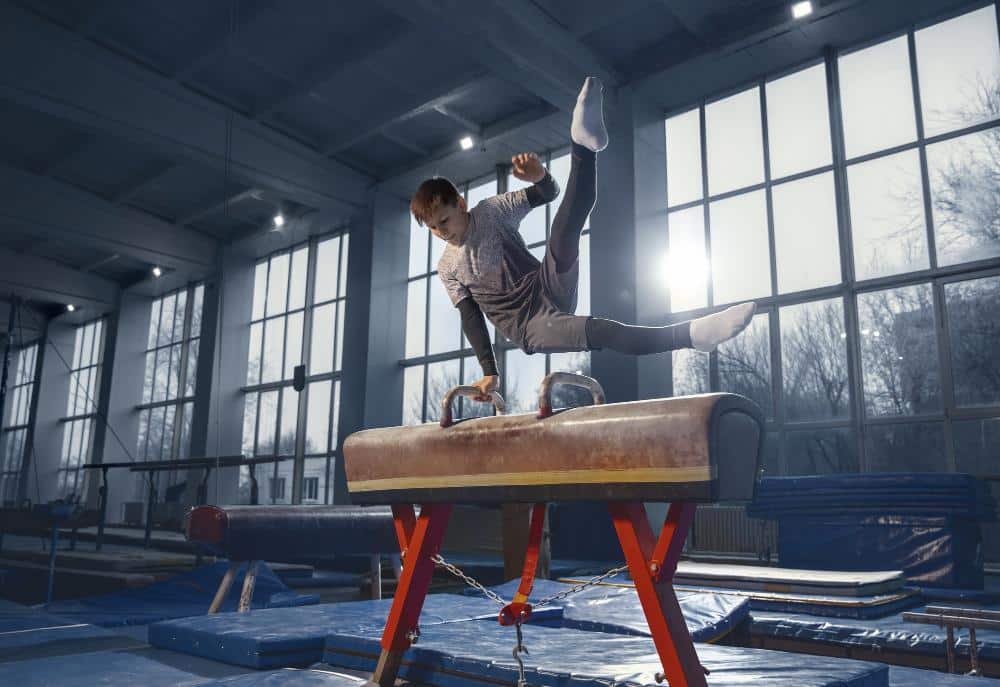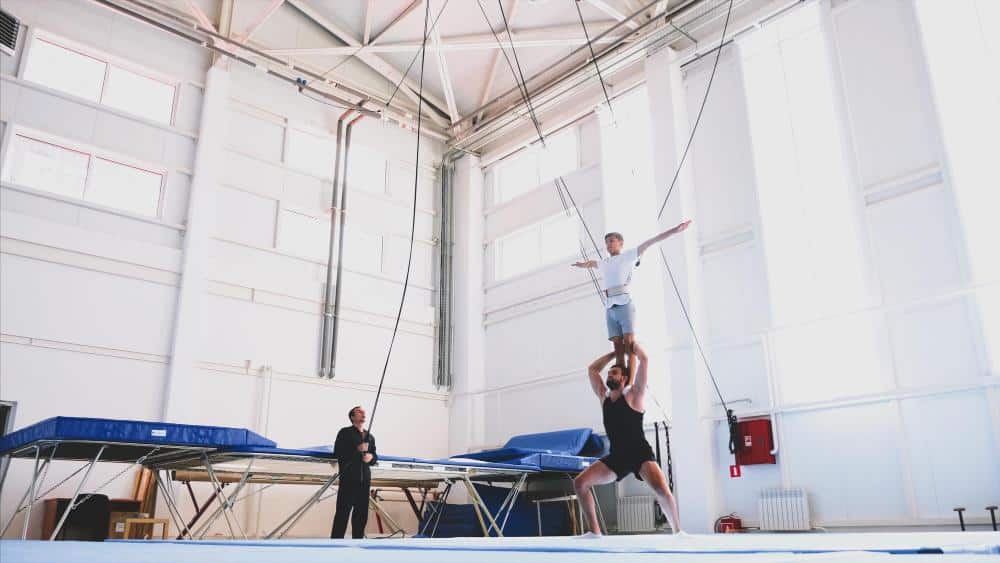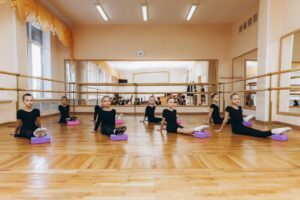While it’s true that acrobatics and gymnastics are both physical activities involving similar movements like impressive passes and tumbling skills, they’re also art forms with key differences.
In acrobatics or acro dance, the emphasis is on balance, agility, and flexibility. Acro dancers do challenging and intricate movements that require a lot of physical strength and control. Acrobatics often involves working with others, like building human pyramids or balancing on top of each other.
On the other hand, gymnastics is a sport that’s more structured. It’s where athletes perform calculated routines on special equipment like the balance beams or spring floor. Precision and technical skills are crucial in gymnastics. In competitions, gymnasts get judged on factors like execution and difficulty, so gymnasts train hard to improve their skills in these areas.
In this blog, we’ll look at the world of acrobatics and gymnastics and understand the distinct characteristics that set them apart.
What is acrobatics?

Acrobatics is a physical discipline and performance art involving strength, agility, balance, and coordination. It is meant to supplement dance training and is typically taught in a dance studio with a sprung floor that absorbs shocks beneath a hard floor, such as wood. It encompasses various activities and skills, including flips, somersaults, handstands, and other movements that showcase the gymnast’s flexibility and control.
Acrobatics can be practised individually or in groups and is often performed in various settings. The goal of acrobatics is to execute impressive and often gravity-defying feats with precision and skill, captivating audiences with the performers’ athleticism and coordination.
Defining characteristics:
- Performance art: dynamic displays in various settings.
- Acro tricks: incorporates acrobatic tricks that highlights physical prowess. No use for equipment as dancers’ bodies are the tools themselves.
- Accuracy and control: demands accurate execution for safety and skill.
- Visual impact: captivates with visually impressive feats, emphasising aesthetics.
- Flexibility of movements: demonstrates a wide range of body movements and poses.
- Dynamic and gravity-defying feats: involve aerial flips, twists, and balancing acts.
- Versatility: can be performed in circuses, gymnastics, dance, and other entertainment events.
What is gymnastics?

Gymnastics is a competitive sport that involves performing a series of routines, typically on various apparatus such as the balance beam, uneven bars, vault, and floor exercise. The sport requires a combination of strength, flexibility, balance, and coordination. Gymnasts work on a spring floor with actual coils built into the mat to give them optimal bounce and safety during hard tumbling runs.
Gymnastics is often divided into different categories:
Artistic gymnastics- the most well-known form, features performances on apparatus that showcase strength, flexibility, and dynamic movements.
Rhythmic gymnastics- involves choreographed routines with rhythmic and expressive elements using apparatus like ribbons, hoops, and clubs.
Trampoline gymnastics– focuses on movements performed on a trampoline.
Acrobatic gymnastics- involves dynamic partner or group routines with lifts, balances, and synchronised movements.
Gymnastics is not only a competitive sport but also a popular recreational activity that promotes physical fitness, discipline, and artistic expression. It is featured prominently in events like the Olympic Games, where gymnasts from around the world compete to showcase their skills and athleticism.
Defining characteristics:
- Competitive Sport: Gymnastics is a competitive athletic discipline, i.e. Olympics
- Apparatus: Involves routines on varied equipment like balance beams, bars, and vaults.
- Strength and Flexibility: Requires a balance of strength and flexibility.
- Technique: Judges evaluate based on execution, difficulty, and artistry.
- Recreational Activity: Popular as both a competitive sport and recreational activity.
- Discipline and Dedication: Requires discipline, dedication, and rigorous training.
Acrobatics vs Gymnastics: Key Differences

Even if acrobatics and gymnastics share similarities in their ability to improve and showcase the performer’s physical prowess and artistic dedication, they still have differences that we must learn about.
Art vs Sport
Acrobatics often finds its place in circuses, street performances, and entertainment shows where performers collaborate to create visually stunning group routines. Acro dancers often hold a vision and personal interpretation of the music as they tell the story of the dance through their bodies.
Gymnastics, on the other hand, is a competitive sport where individuals or teams perform rigorous routines on various pieces of equipment such as the floor, balance beam, parallel bars, and vault to achieve the highest score based on technique, execution, and difficulty.
Grace vs Precision
Acrobatics focuses on balances, tumblings, and contortions executed with grace and long lines. It is often fused into a lyrical, contemporary, or jazz routine, making it more of an art form than just a physical exercise. It is artistic dancing and incorporates seamless transitions before and after acrobatic tricks to exude the performance’s feeling, spirit, and character. Acrobatics also strongly emphasises the performance’s visual appeal while incorporating dance, music, and theatrical elements to captivate the audience.
On the other hand, gymnastics prioritises precision and adherence to a strict set of rules and criteria. Gymnasts are athletes who have undergone meticulous training. Their primary goal is to excel and emerge victorious. The results of their hard work are showcased in their gymnastics floor routine. While there is room for artistic expression, the focus remains on executing routines flawlessly to earn points from the judges.
Body vs Equipment
Acrobatics’ dance choreography primarily relies on human bodies to create formations, pyramids, and lifts, with minimal reliance on specialised equipment. The acro dancer uses their body as a tool to express their interpretation of the music.
On the other hand, gymnastics incorporates a variety of apparatuses, each requiring specific skills and techniques. These include the floor exercise, uneven bars, balance beam, vault, and pommel horse.
A Final Word
Even if each discipline brings its own unique flavour to the stage, acrobatic arts and gymnastics can captivate audiences, inspiring awe and admiration for the physical feats achieved by the performers.
In the end, both acrobatics and gymnastics create stunning performing routines that leave audiences in awe at the beauty and power of movement.
As we understand the differences that make acrobatics and gymnastics distinct, we must recognise their shared commitment to physical excellence, artistic expression, and the ability to inspire audiences worldwide. In the end, whether soaring through the air in acro dance classes or executing flawless advanced tumbling lines, these two disciplines remind us of the incredible capabilities of the human body and spirit.




